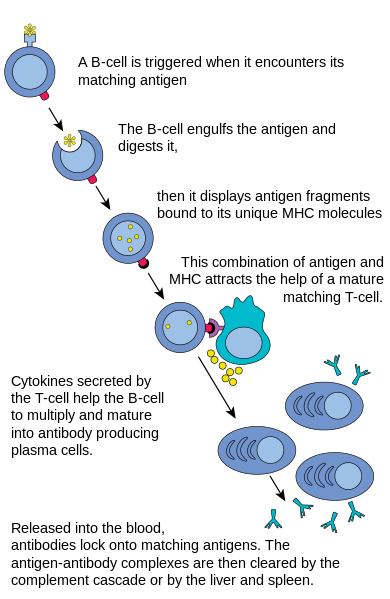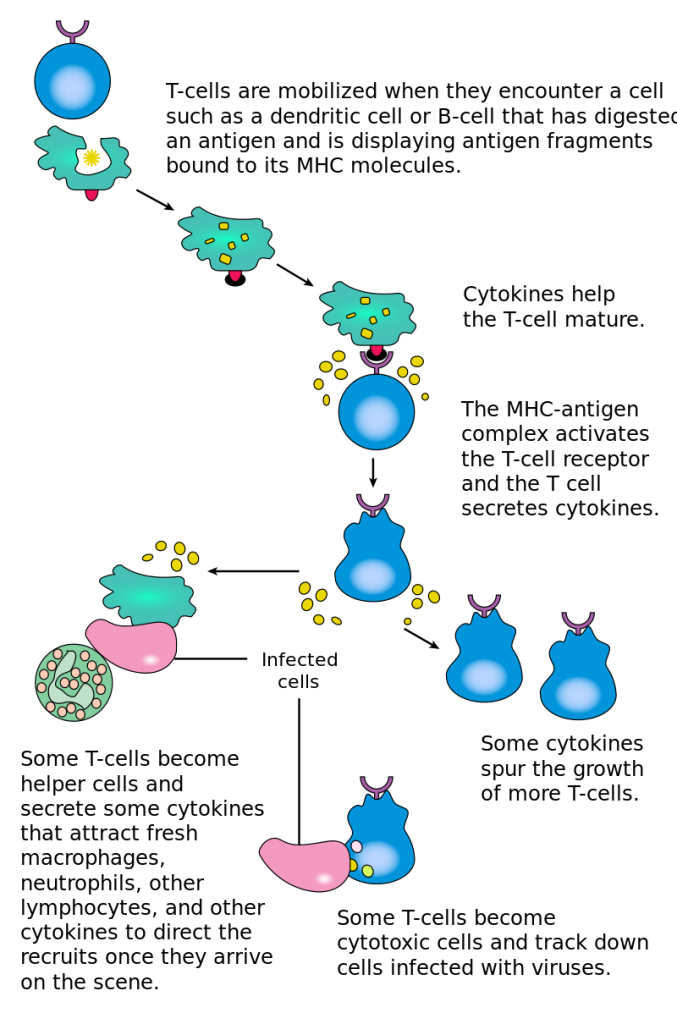
Pathology
Immune Responses
Regarding cytotoxic T cells, which of the following statements is CORRECT:
Answer:
CD8+ T-cells (Cytotoxic T cells)- Recognise antigen only in association with HLA Class I molecules (found on all nucleated cells; present endogenous antigens such as those found in cells infected by viruses or intracellular bacteria.)
- Comprise about 25% of peripheral T-cells
- Responsible for cytotoxic killing of target cells
Lymphocytes
Pathology / Immune Responses
Last Updated: 10th July 2019
In postnatal life, the bone marrow and thymus are the primary lymphoid organs in which lymphocytes develop. The secondary lymphoid organs in which specific immune responses are generated are the lymph nodes, spleen and lymphoid tissues of the alimentary and respiratory tracts.The adaptive immune response depends upon two types of lymphocytes, B and T cells, which derive from the haemopoietic stem cell. Naive B and T cells which leave the bone marrow and thymus are resting cells that are not in cell division. They recirculate in the lymphatic system. Specialised macrophages called dendritic cells (antigen presenting cells, APCs) process antigens before presenting them to B and T cells. T and B cells undergo clonal expansion if they meet an APC that is presenting an antigen that can trigger their antigen receptor molecules. At this stage, lymphocytes can develop into effector cells (e.g. plasma cells, cytotoxic T cells) or memory cells. Antigen-specific immune responses are generated in secondary lymphoid organ and commence when antigen is carried into a lymph node.
B Lymphocytes
B-cells (20% of lymphocytes) mature in the bone marrow and circulate in the peripheral blood until they undergo recognition of antigen. B-cell immunoglobulin molecules synthesised in the cell are exported and bound to the surface membrane to become the B-cell receptor (BCR) which can recognise and bind to a specific antigen (either free or presented by APCs). The BCR is also important for antigen internalisation, processing and presentation to T helper cells. Most antibody responses require help from antigen-specific T helper cells (although some antigens such as polysaccharide can lead to T-cell independent B-cell antibody production).
When the B-cell is activated, the receptor itself is secreted as free soluble immunoglobulin and the B-cell matures into a memory B-cell or a plasma cell (a B-cell in its high-rate immunoglobulin secreting state). Plasma cells are non-motile and are found predominantly in the bone marrow or spleen. Most plasma cells are short-lived (1 - 2 weeks) but some may survive much longer. A proportion of B-cells persist as memory cells, whose increased number and rapid response underlies the augmented secondary response of the adaptive immune system.

B-cell Activation. (Image by Fred the Oyster [Public domain])
T Lymphocytes
T-cells (80% of lymphocytes) develop from cells that have migrated to the thymus where they differentiate into mature T-cells during passage from the cortex to the medulla. During this process, self-reactive T-cells are deleted whereas T-cells with some specificity for host human leucocyte antigen (HLA) molecules are selected. HLA molecules are glycoproteins expressed on the cell surface and consist of cytoplasmic transmembrane and extracellular portions. T-cells have T-cell receptors (TCR) which recognise antigen only when it is presented in association with 'self' HLA molecules.
T-cells may be CD8 or CD4 receptor positive:
- CD4+ T-cells (Helper T cells)
- Recognise antigen only in association with HLA class II molecules (found on antigen presenting cells (APCs) e.g. dendritic cells, B-cells; present exogenous antigens that have been phagocytosed/endocytosed into intracellular vesicles)
- Form most of the circulating T-cell population (about 75%)
- Secrete cytokines (e.g. IFN-gamma) which are required for recruitment and activation of other immune cells such as macrophages, T cytotoxic cells and NK cells and for the activation of and production of immunoglobulin from B-cells
- CD8+ T-cells (Cytotoxic T cells)
- Recognise antigen only in association with HLA Class I molecules (found on all nucleated cells; present endogenous antigens such as those found in cells infected by viruses or intracellular bacteria.)
- Comprise about 25% of peripheral T-cells
- Responsible for cytotoxic killing of target cells

T-cell Activation. (Image by Hazmat2 [Public domain])
Natural Killer Cells
Natural killer (NK) cells are cytotoxic CD8 positive cells that lack the T-cell receptor. They are large cells with cytoplasmic granules.
NK cells are designed to kill target cells that have a low level of expression of HLA class I molecules, such as may occur during viral infection or on a malignant cell. NK cells do this by displaying several receptors for HLA molecules on their surface. When HLA is expressed on the target cell these deliver an inhibitory signal into the NK cell. When HLA molecules are absent on the target cell this inhibitory signal is lost and the NK cell can then kill its target.
In addition, NK cells display antibody-dependent cell-mediated cytotoxicity. In this, antibody binds to antigen on the surface of the target cell and then NK cells bind to the Fc portion of the bound antibody and kill the target cell.

Complementary Activities of Cytotoxic T cells and NK Cells. (Image by Cacofonie [CC BY-SA 3.0])
Report A Problem
Is there something wrong with this question? Let us know and we’ll fix it as soon as possible.
Loading Form...
- Biochemistry
- Blood Gases
- Haematology
| Biochemistry | Normal Value |
|---|---|
| Sodium | 135 – 145 mmol/l |
| Potassium | 3.0 – 4.5 mmol/l |
| Urea | 2.5 – 7.5 mmol/l |
| Glucose | 3.5 – 5.0 mmol/l |
| Creatinine | 35 – 135 μmol/l |
| Alanine Aminotransferase (ALT) | 5 – 35 U/l |
| Gamma-glutamyl Transferase (GGT) | < 65 U/l |
| Alkaline Phosphatase (ALP) | 30 – 135 U/l |
| Aspartate Aminotransferase (AST) | < 40 U/l |
| Total Protein | 60 – 80 g/l |
| Albumin | 35 – 50 g/l |
| Globulin | 2.4 – 3.5 g/dl |
| Amylase | < 70 U/l |
| Total Bilirubin | 3 – 17 μmol/l |
| Calcium | 2.1 – 2.5 mmol/l |
| Chloride | 95 – 105 mmol/l |
| Phosphate | 0.8 – 1.4 mmol/l |
| Haematology | Normal Value |
|---|---|
| Haemoglobin | 11.5 – 16.6 g/dl |
| White Blood Cells | 4.0 – 11.0 x 109/l |
| Platelets | 150 – 450 x 109/l |
| MCV | 80 – 96 fl |
| MCHC | 32 – 36 g/dl |
| Neutrophils | 2.0 – 7.5 x 109/l |
| Lymphocytes | 1.5 – 4.0 x 109/l |
| Monocytes | 0.3 – 1.0 x 109/l |
| Eosinophils | 0.1 – 0.5 x 109/l |
| Basophils | < 0.2 x 109/l |
| Reticulocytes | < 2% |
| Haematocrit | 0.35 – 0.49 |
| Red Cell Distribution Width | 11 – 15% |
| Blood Gases | Normal Value |
|---|---|
| pH | 7.35 – 7.45 |
| pO2 | 11 – 14 kPa |
| pCO2 | 4.5 – 6.0 kPa |
| Base Excess | -2 – +2 mmol/l |
| Bicarbonate | 24 – 30 mmol/l |
| Lactate | < 2 mmol/l |

